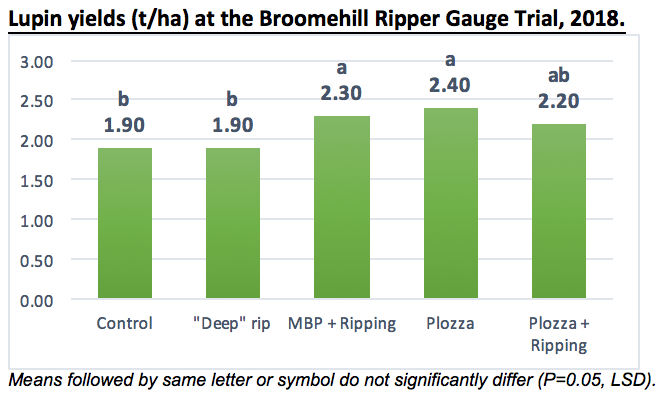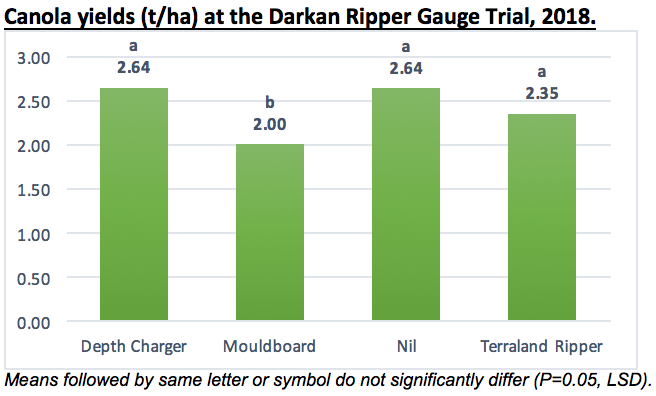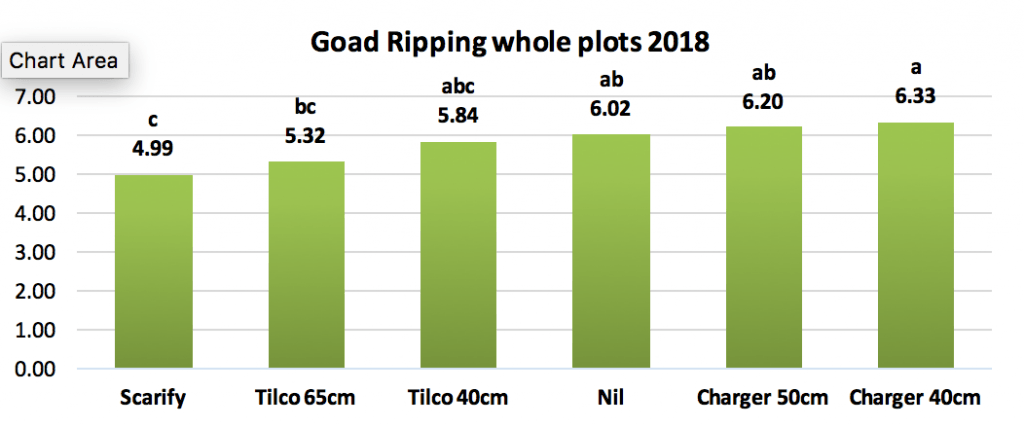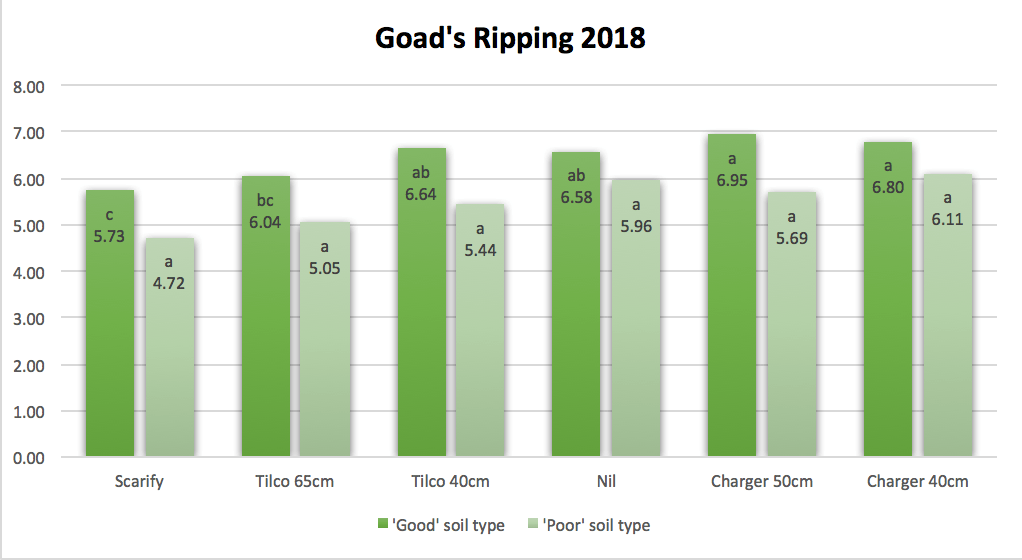
Project Overview
Investment:
Participating Groups:
GRDC
Stirlings to Coast Farmers & Southern Dirt
Project Duration:
Project Hosts:
Three years (2018-2021)
- Paul Duffield – Darkan
- Craig Bignell – Broomehill
Research Authors:
Nathan Dovey, Stirlings to Coast Farmers, and Emma Russell, Southern Dirt
Key Points - 2018 Results
Most soil amelioration treatments improved grain yields or were statistically equivalent to the untreated controls (UTC) at the Ripper gauge sites in the Albany PZ in 2018.
Despite a late break to the season, Albany PZ received a good finish, which meant all ripper gauge trial sites achieved above average yields. Three different crops were grown at each site in canola, lupins and barley.
The good finish to the 2018 growing season meant the yield penalty for soil compaction was reduced & there was not always a significant yield difference between treatments & the untreated controls.
Growers are most interested in the results of the ripper gauge demonstrations in the second and third seasons to measure costs of installation compared to lasting yield benefits.
Project Aim
To evaluate the grain yield and economic benefit of soil amelioration and controlled traffic practices to alleviate non-wetting soils, compaction and waterlogging on a broad range of soil types across selected port zones of WA.
Project Background
Soil amelioration is a key part of farming systems in Western Australia to overcome soil limitations to crop production. The removal of soil constraints such as compaction and water repellence through strategic tillage practices generally lead to increases in crop production in successive years. One of the limitations that threaten the longevity of the benefits of strategic tillage practices is that the soil can compact over time following amelioration. This often leads to levels higher than before amelioration. Currently, the solution is to repeat the deep ripping process every few years, with the period between deep ripping dependant on the soil type and amount of wheeled traffic on the paddock. This is a costly repetitive process that may become unsustainable in the long term as soils become compacted to greater depths with successive tillage treatments and larger and heavier machinery.
While there is a good network of demonstration sites established across the port zones of WA, there are a number of soil types where the benefit and longevity of soil amelioration practices are unknown. The use of controlled traffic practices can be implemented to increase the longevity of soil ameliorative practices, by reducing soil compaction from wheel traffic by confining this to permanent wheel tracks across the paddock. However, the potential of controlled traffic practices to increase the longevity of amelioration treatments have been evaluated on a narrow range of responsive soil types.
Trial Details
Three trial sites were established in 2018 in the Albany port zone on distinct soil types with Southern Dirt and Stirlings to Coast Grower groups. Trial demonstrations included four, five and six different treatments at the Darkan, Broomehill and Kojaneerup (Stirlings to Coast Grower Group) respectively.
Each trial had at least two replicates, which allowed us to conduct appropriate statistical analyses on each site. Base line measurements of soil fertility and compaction were completed prior to seeding in 2018. In-crop assessments were taken during the growing season which included NDVI readings, plant counts, soil strength (at field capacity) and grain yield.
Broomehill Ripper Guage Site - Craig Bignell
| Details | |
|---|---|
| Plot Size & Replication: | Various widths/lengths x 3 replications |
| Soil Type: | Grey Shallow Sandy Duplex |
| Soil pH: | 4.9 – 5.4 CaCI2 |
| Crop Type: | Jurien Lupins, 2018 |
| Sowing Date: | 23rd May, 2018 |
| Sowing Rate: | 100kg/ha |
| Fertiliser: | MAP 55kg/ha and MOP 40kg/ha |
| Number | Treatment | Depth |
|---|---|---|
| 1 | Mouldboard and Deep Ripper (Ausplow) | 35cm & 25cm |
| 2 | Control | Nil |
| 3 | Deep Ripper | 25cm |
| 4 | Plozza Plough and Deep Ripper (Ausplow) | 20cm & 25cm |
| 5 | Plozza Plough | 20cm |
Results

Figure 1: Lupin yields (t/ha) of the Broomehill Ripper Gauge site hosted by the Bignell family in 2018. This trial site was placed on a gravelly duplex soil type displaying non-wetting characteristics on the surface.
| Treatments | NDVI July 17th | NDVI August 30th |
|---|---|---|
| MBP & Rip | 21.44 | 60.67 |
| Control | 17.67 | 56.11 |
| Deep Rip | 21.00 | 62.00 |
| Plozza & Rip | 20.44 | 65.11 |
| Plozza | 19.89 | 62.44 |
Table 1: Summary of the two Normal Different Vegetation Index (NDVI) readings taken from the Broomehill Ripper Gauge site in 2018. NB: Data is yet to be analysed statistically.
The NDVI readings from the Broomehill site have not been analysed yet. The NDVI differences between treatments appear to be minimal apart from comparisons between the control treatment and the Plozza & Rip treatment taken on August 30th, 2018.
Summary
Two of the four amelioration treatments yielded significantly higher than the untreated control. The ‘Deep rip only’ treatment yielded 1.9t/ha and the the Plozza + Deep Ripping yielded 2.2t/ha, which was statistically equivalent to the control.
The yield improvements for the ‘MBP + Ripping’ and the ‘Plozza’ were statistically equivalent to each other. However, they had a 400 and 500kg/ha yield improvement respectively over the untreated control which was statistically significant.
The ‘Plozza + Ripping’ yielded 200kg/ha less than the Plozza treatment alone, although the difference was not statistically significant. The second pass through the soil may have dried it out, which exacerbated the non-wetting soil surface. The ripper was also only ripping to 25cm which may not have alleviated the compaction layer.
Another hypothesis for the poor 2018 yield result from the ripper alone, was that the other soil amelioration machinery mixed the soil, which could have alleviated some of the non-wetting top-soil. The second pass, ripping the soil, dried it out more which reduced germination percentages and reduced early crop vigor.
The mouldboard plough reached a soil depth of 35cm, the Plozza 20cm and the ripper only reached 25cm on average.
Darkan Ripper Gauge Site – Paul Duffield
| Details | |
|---|---|
| Plot Size & Replication: | 15m x 200m strips x 3 replications |
| Soil Type: | Forest Gravel |
| Soil pH: | 4.5 – 6.0 CaCI2 |
| Crop Type: | Mako Canola TT, 2018 |
| Sowing Date: | May 2018 |
| Sowing Rate: | 5kg/ha |
| Fertiliser: | Lime 2t/ha MAPSZC MOP 75+25 100kg/ha Urea 100kg/ha NS 31 80kg/ha UAN 30l/ha |
| Number | Treatment | Depth |
|---|---|---|
| 1 | Depth Charger (RocksGone) | 40cm |
| 2 | Mouldboard | 30cm |
| 3 | Nil | N/A |
| 4 | Terraland Deep Ripper | 35cm |
Results

Figure 2: Canola yields (t/ha) in the Darkan Ripper Gauge site hosted by the Duffield family. The trial site was located on a gravelly non-wetting soil.
| Treatments | NDVI June 13th | NDVI August 21st |
|---|---|---|
| Depth Charger | 19.33 | 0.67 |
| Mouldboard | 12.56 | 0.42 |
| Terraland | 18.44 | 0.70 |
| Nil | 16.33 | 0.56 |
Table 2: Summary of the two Normal Different Vegetation Index (NDVI) readings taken from the Darkan Ripper Gauge site in 2018. NB: Data is yet to be analysed statistically.
The NDVI data from the Darkan ripper gauge site has not being analysed yet. The pattern from the two NDVI readings times appear consistent to each other, whilst also matching the final grain yields. The researcher and farmer observations that the mouldboard plough treatments lacked plant numbers and therefore early biomass are supported from the data shown in table four.
Summary
No amelioration machinery improved the canola yield in 2018 over and above the untreated control (Nil).
Two treatments, Depth Charger and Terraland ripper, were statistically equivalent to the Nil treatment.
The Moulboard plough yielded significantly less than the other three treatments, including the untreated control (Nil). This was probably because of a poorer plant germination in the mouldboard plough treatment. We are awaiting analysis of the NDVI readings taken during the growing season in 2018. The Raw data suggests there was less crop biomass for the mouldboard plough treatment compared to all other treatments.
The 2018 season was kind to the Darkan area with steady rainfall throughout the growing season. This may have contributed to the lack of yield differences between the amelioration treatments and the untreated control (nil).
Kojaneerup Ripper Gauge Site – Josh and Tony Goad
| Details | |
|---|---|
| Plot Size & Replication: | 3 replications |
| Soil Type: | White sandplain soil |
| Soil pH: | 0-10cm 4.7-5.0, 10-20cm 4.1-4.5, 20-30cm 4.5-4.9 |
| Crop Type: | Rosalind Barley, 2018 |
| Sowing Date: | 2018 |
| Number | Treatment | Depth |
|---|---|---|
| 1 | Scarify | |
| 2 | Tilco | 65cm |
| 3 | Nil | N/A |
| 4 | Tilco | 40cm |
| 5 | Depth Charger | 50cm |
| 6 | Depth Charger | 40cm |
Results

Means followed by same letter or symbol do not significantly differ (P=.05, LSD).
Figure 3: 2018 Ripper gauge site located on the Goad family farm in Kojaneerup WA. This trial was located on a white sandplain soil with depth to gravel varying from 30-80cm. This graph displays barley grain yields in (t/ha) over the whole length of the plots.

Means followed by same letter or symbol do not significantly differ (P=.05, LSD).
Figure 4: Displays the 2018 Ripper gauge site located with the Goad family at Kojaneerup WA. Trial was located on white sandplain soil with depth to gravel varying from 30-80cm. Data displays the plots being split into the high and low yielding sections. Labels on the bars, indicate the barley grain yield in t/ha.
| Treatment | Ave NDVI July 21st | Ave NDVI Aug 26th | Ave plant numbers/m2 |
|---|---|---|---|
| Tilco 40cm | 0.39a | 0.64a | 27.9a |
| Tilco 65cm | 0.33a | 0.65a | 25.8a |
| Depthcharger 40cm | 0.45a | 0.63a | 27.7a |
| Depthcharger 50cm | 0.38a | 0.65a | 28.0a |
| Nil | 0.38a | 0.64a | 25.8a |
| Scarifier 15cm | 0.42a | 0.69a | 30.6a |
Table 3: Displays the average NDVI readings from the 21st of July and August 26th at the Kojaneerup (Goad) Ripper Gauge demonstration site in 2018. The average plant counts per metre squared were also recorded on July 21st.
Statistical analysis on the biomass readings and the plant counts show no significant differences between any of the treatments in the Goad ripping trial located at Kojaneerup.
Summary
Yields indicate no significant improvements in grain yield from any of the tillage treatments compared to the nil treatment.
The trial site suffered from at least three very strong wind events before and just after seeding. This caused some of the sandy top-soil to move, particularly on the deeper ripped treatments from the Tilco and the Depthcharger.
The scarifier (15cm) was the only treatment that yielded significantly less than the nil. We suspect this is because the soil disturbance exacerbated the non- wetting nature of the soil which delayed plant emergence and reduced overall crop biomass. The scarifying treatment was installed much closer to the seeding date than both the Tilco and Depthcharger rippers.
On the poor, lighter sandy soil type, there was no significant difference between any of the treatments in the 2018 trial (See figure 2).
Wind erosion early in the growing season caused delays in emergence and left some bare patches within the trial area. Josh Goad spot-seeded some of these bare patches after seeding to provide ground cover. The tactic was very effective, and these patches were not visible at harvest time.
Conclusion
Most treatments yielded statistically higher, or at least equal to the untreated control across the three trial demonstrations.
Only two treatments yielded significantly less than the untreated control (nil). They were the scarifier treatment at Kojaneerup and the mouldboard plough treatment at Darkan. Both treatments dried the soil profile out excessively, which reduced germination percentages and early vigor.
In general, the Albany port zone received an adequate finish to the season where reasonable rains and low ambient temperatures allowed crops to reach close to their water limited yield potential. The good finish to the growing season meant that the yield penalty for soil compaction as reduced at all three ripper gauge demonstration sites, therefore, there was not massive yield differences between treatments in the 2018 season.
NB: Scarifying to 15cm is not a viable treatment we are considering for amelioration of non-wetting or compacted soils. It was included in the treatment list at Kojaneerup to see if there was a positive effect on yield in the first year after tillage.
Acknowledgements
Thank you to Grains Research & Development Corporation for investing in this project.
Thank you to Josh Goad (Kojoneerup) Craig Bignell (Broomehill) and Paul Duffield (Darken) for hosting, implementing and maintaining the trial sites.
Finally thank you Tim Pannell from Rock Gone for the demonstration of the Depth Charger and John Davies with his Terraland Ripper.

